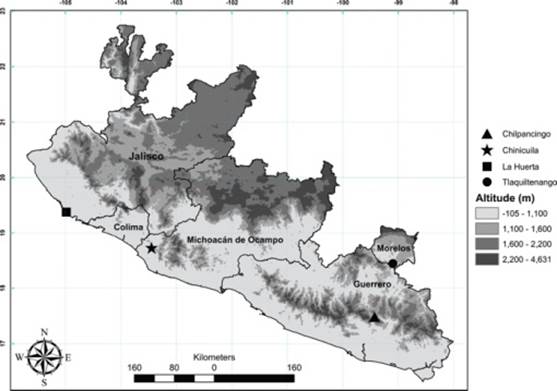The genus Ficimia (Gray, 1849) contains seven species of small secretive colubrid snakes, all of which are considered rare (Hardy, 1975; Mendoza & Smith, 1993). The included species are: F. hardyi, F. olivacea, F. publia, F. ruspator, F. ramirezi, F. streckeri, and F. variegata. The genus Ficimia is diagnosed by the presence of a rostral scale contacting the frontal and smooth dorsal scales in 17 rows at midbody. Ficimia is distributed from southern Texas in the United States southward through eastern and western Mexico, on the Mexican Plateau, and southward through southeastern Mexico, to the Yucatán Peninsula, Guatemala, Belize, and northern Honduras (Hardy, 1975). The genus was thoroughly reviewed by (Smith & Taylor, 1941) and again by (Hardy, 1975).
Ficimia publia (Cope, 1866) is a terrestrial, semi-fossorial, and largely nocturnal species that feeds mostly on centipedes; it is the most widespread member of the genus. It was first described by (Cope, 1866); the type locality was listed as Yucatán, but no exact location was provided. In view of its wide distribution and occurrence in several protected natural areas, the IUCN (Ariano-Sánchez & Lee, 2013) considered F. publia a non-threatened species (listed as Least Concern), and (Wilson et al., 2013) scored it at the upper end of the low vulnerability level.
Historically, (Smith, 1943) reported F. publia from Chilpancingo, Guerrero and four years later from Veracruz (Smith, 1947). (Peters, 1953) first reported this species from Quintana Roo, (Webb & Fugler, 1957) from Puebla, and (Neill & Allen, 1961) from Belize. (Hensley & Smith, 1962) included Tabasco in the range, (García & Valtierra-Azotla, 1996) noted its occurrence on the Pacific coastal region of Jalisco, and (Castro-Franco & Bustos-Zagal, 2004) reported it for the first time in Morelos. Presently, the known distribution of F. publia ranges from northern Veracruz on the east, Puebla and Morelos in central Mexico, and southern Jalisco on the west, southward to Guerrero, Oaxaca, Tabasco, Chiapas, the Yucatán Peninsula of Mexico and Central America, south-central Guatemala, and northwestern Honduras (McCranie, 2011). Locations where F. publia have been registered were found below 1500 m elevation (mostly below 1000 m elev.) in a variety of vegetation formations from tropical wet forests through subtropical dry forests (Hardy, 1980; Wilson & Johnson, 2010). There is a distributional gap in the range of this species on the Pacific lowlands of Mexico between Jalisco and Guerrero that encompasses the states of Colima and Michoacán (Fig. 1).

Figure 1: Collecting site of Ficimia publia in Michoacán and nearest localities where the species was previously collected in the surrounding states of Jalisco, Guerrero, and Morelos.
Herein we report for the first time, the presence of F. publia in the state of Michoacán. An adult female (TL: 175 mm) was found dead on 24 August 2014 by Jesús Ibarra Medina on Carretera Federal 120 between Coalcomán and Aquila in the Municipality of Chinicuila (18.662413° N -103.436682° W; WGS 84; 990 m elev.; Fig. 1). The dominant vegetation type in the area was tropical deciduous forest. The specimen was deposited in the Colección Herpetológica de la Universidad Michoacana (HINIRENA). This locality represents a range extension of 179 airline km southeast from closest known record at Rancho Cuixmala, Municipality of La Huerta, Jalisco (Fig. 1; García & Valtierra-Azotla, 1996). The closest known localities in adjacent states (Fig. 1) are at Chilpancingo, Guerrero (Smith 1943) and Tlaquiltenango, Morelos (Castro-Franco & Bustos-Zagal, 2004). Presently, Colima is the only Mexican state where this species has not been recorded on the Pacific versant below Jalisco, but considering the similarity in elevational range and vegetation types, F. publia should eventually be reported from there in low to moderate elevations.











 nova página do texto(beta)
nova página do texto(beta)


